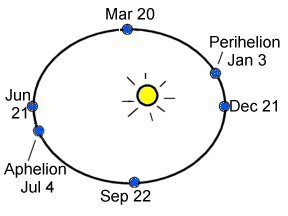The time when the earth is closest to the sun is actually January 3rd for the northern hemisphere, this process was supposed to warm the winter and cool the summer somewhat

In fact, the Earth is at its greatest distance from the Sun at the beginning of July and closest to it at the beginning of January.
The difference in the distance between the earth and the sun between these two extremes reaches 5 million km or 3.3 percent, which results in a difference in the heating of the earth by the sun of about 7 percent, however for the northern hemisphere, this process was supposed to warm the winter and cool somewhat the summer.
The seasons, however, are not caused by the changes in the distance between the Earth and the Sun. The changes in seasons are caused by the 23.5 degree tilt in the Earth's rotation axis, which causes other parts of our planet to be turned towards the Sun at different times of the year. Summer in the Northern Hemisphere occurs when this half of the planet is oriented towards the sun and therefore the days are longer and maximum sunlight reaches these areas.
The accidental accumulation of a large land mass in the Northern Hemisphere also has an effect - and its winters are colder and its summers are hotter than those in the Southern Hemisphere. The land heats up and cools down faster than the water. The Northern Hemisphere has a larger area of oceans, which moderates the temperature and helps make the winters a little milder and the summers a little colder.
Here's another way to think about it: in the Northern Hemisphere, if we think of "cold gusts" during the winter we mean gusts of cold air coming south from Canada or Siberia, where it builds. It has no equivalent in the southern hemisphere. There is no land mass there that can produce such cold gusts of wind.
There are also some oddities though, when we compare the temperatures at the North Pole vs. the South Pole, the South Pole wins because Antarctica is a landlocked continent unlike the North Pole, where there is no solid mass at all.
However, Antarctica is completely surrounded by water, so any cold air that comes out of it is significantly moderated when it makes its way towards Australia, South Africa and South America.
